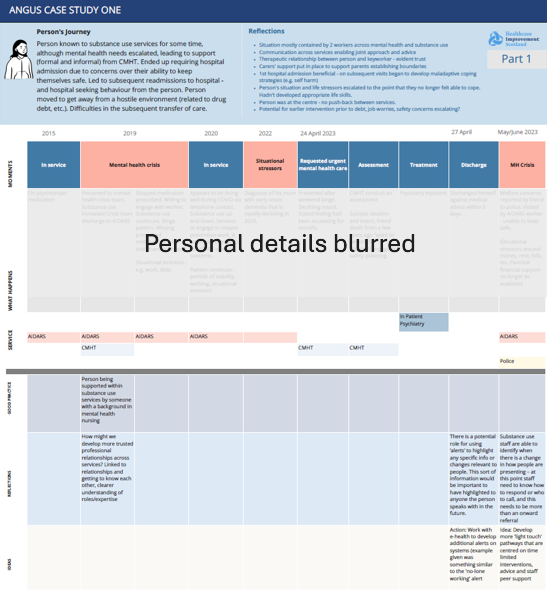Journey Mapping
About journey mapping
A user journey map is a useful tool to provides visual representation of a person’s journey. This should include their interactions with services. It should show the person's experiences, emotions, and actions at each stage.
Journey maps can help raise awareness and support the need for change. It can identify key touchpoints to consider. It can increase understanding of pathways across the health and care system.
Through this approach you can:
- See the detail of how a person interacts with services,
- Break down and understand complex journeys across multiple touchpoints,
- Highlight where there might be good practice and/or areas for improvement, and
- Use pain points as a starting point for developing change ideas.
Supporting your protocol development – how you might use this tool:
When looking at developing and implementing a local protocol, this tool can:
- Note points where people are falling through gaps in services,
- Identify where there are opportunities to build preventative approaches, and
- Build understanding of how mental health and substance use needs present and change over time.
Journey maps will stimulate conversations about:
- the types of things that keep people well,
- which interfaces you should prioritise across mental health and substance use, and
- what you should consider within the local protocol to enable more structured collaboration.
Planning your workshop
This activity can be done as part of a larger workshop, incorporating breakout groups for reflections. Or part of a more focussed conversation with key stakeholders. The production of the journey map itself is part of the preparation for the workshop/conversation, to then be used to generate insights collectively. The resources section has further tools and guidance to support your planning.
What you need to do before
|
Developing the Journey Map – typically it is useful to produce two. One that demonstrates challenges supporting people across services, and another that demonstrates good practice supporting people across services.
|
 |
What you will need for the session
- Your completed journey maps
- Prompt questions that will allow people to reflect on the journey, and identify opportunities for change or improvements. See ‘Workshop Agenda’ in the supporting resources section for ideas.
Who should be involved
- All stakeholders you are wanting to engage with or from services involved in the journey being looked at.
- Typically discussion groups of up to 5.
- It is useful to have people familiar with the case to support discussions and provide additional clarifications/insights
During the workshop
Discussion relating to the Journey Maps should be centred on both reflections on what happened and then opportunities for improving practice or building on good practice. The following questions can help guide conversation.
Reflecting on what happened
- Which parts of this experience do you think are the most important?
- Allocation and assessment, how were needs identified? Were some needs missed?
- Working with other services, statutory and third sector. How did it work? Was there evidence of joint working? Knowledge of other services including third sector. Could you refer into appropriate services to support needs?
- Was there points where data was recorded on IT systems?
Reflecting on improving practice or building on good practice
- What are the challenges? Were there gaps, repetition, waiting times or communication issues.
- What good practice did you see or could be shared? What could be improved further?
- Where might there have been opportunities for improvement.
- Are there any training needs that would support you?
Check out the Service Design Tool Directory for more Service Design guidance and resources.
